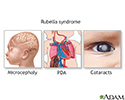Congenital rubella
Congenital rubella is a condition that occurs in an infant whose mother is infected with the virus that causes German measles. Congenital means the condition is present at birth.
Congenital rubella occurs when the rubella virus in the mother affects the developing baby in the first 3 months of pregnancy. After the fourth month, if the mother has a rubella infection, it is less likely to harm the developing baby.
The number of babies born with this condition is much smaller since the rubella vaccine was developed.
Pregnant women and their unborn babies are at risk if:
- They are not vaccinated for rubella
- They have not had the disease in the past
Symptoms
Symptoms in the infant may include:
- Cloudy corneas or white appearance of pupil
- Deafness
- Developmental delay
- Excessive sleepiness
- Irritability
- Low birth weight
- Below average mental functioning (intellectual disability)
- Seizures
- Small head size
- Skin rash at birth
Exams and Tests
The baby's health care provider will run blood and urine tests to check for the virus.
Treatment
There is no specific treatment for congenital rubella. The treatment is symptom-based.
Outlook (Prognosis)
The outcome for a child with congenital rubella depends on how severe the problems are. Heart defects can often be corrected. Damage to the nervous system is permanent.
Possible Complications
Complications may involve many parts of the body.
EYES:
- Clouding of the lens of the eye (cataracts)
- Damage to the optic nerve (glaucoma)
- Damage of the retina (retinopathy)
HEART:
- A blood vessel that usually closes shortly after birth remains open (patent ductus arteriosus)
- Narrowing of the large artery that delivers oxygen-rich blood to the heart (pulmonary artery stenosis)
- Other heart defects
CENTRAL NERVOUS SYSTEM:
- Intellectual disability
- Difficulty with physical movement (motor disability)
- Small head from poor brain development
- Brain infection (encephalitis)
- Infection of the spinal column and tissue around the brain (meningitis)
OTHER:
- Deafness
- Low blood platelet count
- Enlarged liver and spleen
- Abnormal muscle tone
- Bone disease
When to Contact a Medical Professional
Call your provider if:
- You have concerns about congenital rubella.
- You are unsure if you have had the rubella vaccine.
- You or your children need a rubella vaccine.
Prevention
Vaccination prior to pregnancy can prevent this condition. Pregnant women who have not had the vaccine should avoid contact with people who have the rubella virus.
References
Gershon AA. Rubella virus (German measles). In: Bennett JE, Dolin R, Blaser MJ, eds. Mandell, Douglas, and Bennett's Principles and Practice of Infectious Diseases. 9th ed. Philadelphia, PA: Elsevier; 2020:chap 152.
Mason WH, Gans HA. Rubella. In: Kliegman RM, St. Geme JW, Blum NJ, Shah SS, Tasker RC, Wilson KM, eds. Nelson Textbook of Pediatrics. 21st ed. Philadelphia, PA: Elsevier; 2020:chap 274.
Reef SE. Rubella (German measles). In Goldman L, Schafer AI, eds. Goldman-Cecil Medicine. 26th ed. Philadelphia, PA: Elsevier; 2020:chap 344.
Review Date: 4/14/2021
Reviewed By: Charles I. Schwartz MD, FAAP, Clinical Assistant Professor of Pediatrics, Perelman School of Medicine at the University of Pennsylvania, General Pediatrician at PennCare for Kids, Phoenixville, PA. Also reviewed by David Zieve, MD, MHA, Medical Director, Brenda Conaway, Editorial Director, and the A.D.A.M. Editorial team.





